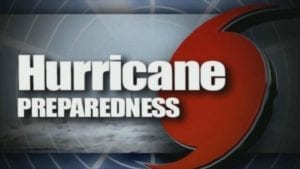With the storm activity in the Gulf of Mexico increasing while we approach the thick of Hurricane season, we wanted to give you, your family and your company a guide on to be prepared in all aspects for an approaching storm. Preparedness is essential for dealing with the challenges of hurricane season, and it will help you and your loved ones keep peace of mind. Here’s a rundown of what you can do to remain safe and prepared before a storm is in the Gulf when it’s approaching, and during it.
 What can you do right now?
What can you do right now?
- Sign up for your community’s warning system. The Emergency Alert System (EAS) and National Oceanic and Atmospheric Administration (NOAA) Weather Radio are also great options for emergency alerts.
- Designate a safe shelter for high winds. The best protection is a small, interior, windowless room in a sturdy building on the lowest level that is not subject to flooding.
- Based on your location and community plans, make your own plans for evacuation or sheltering in place ahead of time. Make multiple plans dependent on the different directions storms can approach your particular location.
- Become familiar with your evacuation zone, the evacuation route, and emergency evacuation shelters.
- Purchase a generator to power necessary utilities. If your family has special health or medical needs, or you absolutely must have air conditioning, be prepared with a generator that can handle it.
- Gather supplies needed for at least three days. Keep in mind each person’s specific needs, including medication. Don’t forget the needs of your pets as well.
- Keep important documents in a safe place or create password-protected digital copies.
- Protect your property:
- Declutter drains and gutters.
- Install check valves in plumbing to prevent backups.
- Consider hurricane shutters.
- Learn how to turn off the gas and power to your home in case needed during a power outage.
- Cut down trees and branches close to your house and car.
- Review insurance policies for wind damage as well as flooding.
- Prevent carbon monoxide (CO) poisoning after a hurricane.
- Ensure your CO detector has working batteries.
When A Storm is Approaching…
- Stay up to date with your local and national weather services, you’ll get the latest weather updates and emergency instructions from them.
- Reassure that your emergency preparedness kit is stocked. Include food and water sufficient for at least three days, medications, a flashlight, batteries, cash, and first aid supplies. Check the expiration dates on food to make sure the food is fresh. Canned foods are a great option for storms.
- Plan how to communicate with your family members if you lose power. Remember, you can call and text via social media as well as iPhone and Android apps that allow for communication via wifi. During disasters, sending text messages is usually reliable and faster than making phone calls because phone lines are often overloaded or damaged.
- Review your evacuation zone, the evacuation route, and shelter locations. Plan ahead with your family, because you may have to leave quickly.
- Maintenance your car and keep the gas tank full; stock your vehicle with emergency supplies and a change of clothes.
- Bookmark your city or county website for quick access to storm updates and emergency instructions.
- Bring loose, lightweight objects inside that could become projectiles in high winds (e.g., patio furniture, garbage cans); strapped down objects that would be unsafe to bring inside (e.g., propane tanks); and trim or remove trees close enough to fall on the building.
- Cover all of your home’s windows. Permanent storm shutters offer the best protection for windows. A second option is to board up windows with 5/8” exterior grade or marine plywood, cut to fit and ready to install.
During A Storm…
- Close storm shutters and stay away from windows. Flying glass from a broken window could injure you.
- Turn your refrigerator or freezer to the coldest setting and open only when necessary.
- Fill up your freezer and refrigerator. The more items there are, the more to retain the cold and keep the overall temperature down, so that if the power goes out, it will retain the cold longer; hopefully in time for the power to turn back on.
- Put all the ice that you have in your freezer into plastic bags. Fill all spaces in your freezer with bags of ice.
- Check your city/county website and TV station every 30 minutes in order to get the latest weather updates and emergency instructions.
- If trapped in a building by flooding, go to the highest level of the building. Do not climb into a closed attic. You may become trapped by rising floodwater.
- Listen to current emergency information and instructions.
- Use a generator or other gasoline-powered machinery outdoors only and away from windows. Place generators outside at least 20 feet from any door, window, or vent to prevent carbon monoxide (CO) poisoning.
- Do not walk, swim, or drive through floodwaters. Just six inches of fast-moving water can knock you off your feet, and one foot of moving water can sweep your vehicle away.
After A Storm…
- Listen to authorities for information and special instructions.
- Be careful during clean-up. Wear protective clothing and work with someone else.
- Do not touch electrical equipment if it is wet or if you are standing in water. If it is safe to do so, turn off electricity at the main breaker or fuse box to prevent electric shock.
- Avoid wading in floodwater, which can contain dangerous debris. Underground or downed power lines can also electrically charge the water.
- Save phone calls for emergencies. Phone systems are often down or busy after a disaster. Use text messages or social media to communicate with family and friends.
- Document any property damage with photographs. Contact your insurance company for assistance.
For more information on how to be best prepared for an incoming hurricane and continuous information about oncoming storms, visit The National Weather Service’s website or call them at (828) 271-4800

